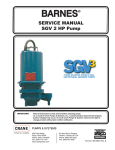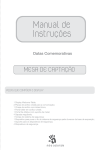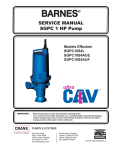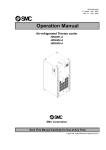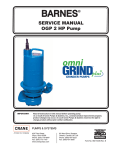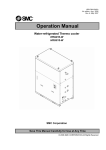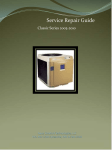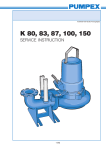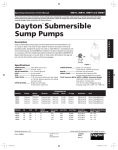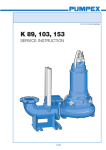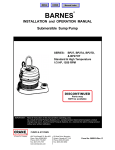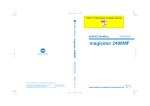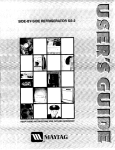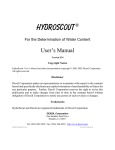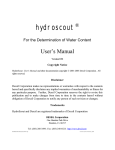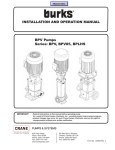Download SGPC 1HP.book
Transcript
BARNES< SGPC 1 HP Service Manual SUPERSEDED Some parts may NOT be available Barnes Pumps, Inc. 420 Third Street/P.O. Box 603 Piqua, Ohio 45356-0603 Phone: (937) 615-3599 Fax: (937) 773-7157 Barnes Pumps Canada, Inc. 83 West Drive, Bramalea Ontario, Canada L6T 2J6 Phone: (905) 457-6223 Fax: (905) 457-2650 Form FormNo. No.SM108093-A SM108093-A TABLE OF CONTENTS SAFETY FIRST TOOL LIST 1 3 SGPC 1 HP Disassembly 5 VISUAL INSPECTION OF PUMP CUT CORDS MEGGER THE PUMP LEADS - (MEGOHMMETER) HI-POT (HIGH POTENTIAL) INSULATOR TEST (IF REQUIRED) CHECK THE RESISTANCE - (MULTI-METER) JAMMED OR WORN CUTTER CHECK VALVE EVALUATION CHECK FOR STATOR / ROTOR ABRASIVE WEAR STATOR FAILURE EVALUATION MOVEABLE ALIGNMENT CUTTER REMOVAL SUCTION HOUSING PUMP ROTOR & PUMP-OUT SPACER PUMP STATOR OIL REMOVAL, PRESSURE CHECK PERFORM PRESSURE CHECK OUTER SHAFT SEAL MOTOR HOUSING SEAL PLATE MOTOR BEARING 5 5 5 5 5 6 6 6 6 6 7 8 9 9 10 10 11 12 13 14 15 SGPC 1 HP ASSEMBLY 17 BEARING TO PUMP ROTOR MECHANICAL SEAL, LOWER BEARING, AND MOTOR ROTOR MOTOR STATOR MOTOR HOUSING PIN PLACEMENT DIAGRAM PERFORM PRESSURE CHECK SUCTION HOUSING PUMP ROTOR AND UPPER PUMP ASSEMBLY REPLACING OIL EXPLODED VIEW OF SGPC 1 HP PARTS KITS 17 18 19 20 21 22 23 24 26 27 28 1 SAFETY FIRST! Please Read This Before Installing Or Operating Pump. This information is provided for SAFETY and to PREVENT EQUIPMENT PROBLEMS. To help recognize this information, observe the following symbols: IMPORTANT! Warns about hazards that can result in personal injury or indicates factors concerned with assembly, installation, operation, or maintenance which could result in damage to the machine or equipment if ignored. CAUTION! Warns about hazards that can or will cause minor personal injury or property damage if ignored. Used with symbols below. WARNING! Warns about hazards that can or will cause serious personal injury, death, or major property damage if ignored. Used with symbols below. Hazardous fluids can cause fire or explosions, burns or death could result. Extremely hot - Severe burns can occur on contact. Biohazard can cause serious personal injury. Hazardous pressure Eruptions or explosions could cause personal injury or property damage. Rotating machinery Amputation or severe laceration can result. Hazardous voltage can shock, burn, or cause death. Only qualified personnel should install, operate, and repair pump. Any wiring of pumps should be performed by a qualified electrician. Warning! - To reduce risk of electrical shock, pumps and control panels must be properly grounded in accordance with the National Electric Code (NEC) or the Canadian Electrical Code (CEC) and all applicable state, providence, local codes and ordinances. Warning! - To reduce risk of electrical shock, always disconnect the pump from the power source before handling or servicing. Lock out power and tag. Prevent large articles of clothing, large amounts of chemicals, other materials or substances such as are uncommon in domestic sewage from entering the system. During power black-outs, minimize water consumption at the home(s) to prevent sewage from backing up into the house. Always keep the shut-off valve completely open when system is in operation (unless advised otherwise by the proper authorities). Before removing the pump from the basin, be sure to close the shut-off valve. (This prevents backflow from the pressure sewer.) Keep the control panel locked or confined to prevent unauthorized access to it. WARNING! Do not pump hazardous materials (flammable, caustic, etc.) unless the pump is specifically designed and designated to handle them. Do not block or restrict discharge hose, as discharge hose may whip under pressure. WARNING! - DO NOT wear loose clothing that may become entangled in the impeller or other moving parts. WARNING! Keep clear of suction and discharge openings. DO NOT insert fingers in pump with power connected. Make sure lifting handles are securely fastened each time before lifting. Do not operate pump without safety devices in place. Always replace safety devices that have been removed during service or repair. Do not exceed manufacturers recommendation for maximum performance, as this could cause the motor to overheat. Secure the pump in its operating position so it cannot tip over, fall, or slide. Cable should be protected at all times to avoid punctures, cut, bruises and abrasions - inspect frequently. Never handle connected power chords with wet hands. To reduce risk of electrical shock, all wiring and junction connections should be made per the NEC or CEC and applicable state or province and local codes. Requirements may vary depending on usage and location. Submersible Pumps are not approved for use in swimming pools, recreational water installations, decorative fountains, or any installation where human contact with the pumped fluid is common. Do not remove cord and strain relief. Do not connect conduit to pump. Products Returned Must Be Cleaned, Sanitized, Or Decontaminated As Necessary Prior To Shipment, To Insure That Employees Will Not Be Exposed To Health Hazards In Handling Said Material. All Applicable Laws And Regulations Shall Apply. Bronze/brass and bronze/brass fitted pumps may contain lead levels higher than considered safe for potable water systems. Various government agencies have determined that leaded copper alloys should not be used in potable water applications. For non-leaded copper alloy materials of construction, please contact factory. If the pump is idle for long periods of time, it is advisable to start the pump occasionally by adding water to the basin. CAUTION! Pumps build up heat and pressure during operation-allow time for pumps to cool before handling or servicing. IMPORTANT! BARNES< Pumps, Inc., is not responsible for losses, injury, or death resulting from a failure to observe these safety precautions, misuse, or abuse of pumps or equipment. Other brand and product names are trademarks or registered trademarks of their respective holders. <Barnes is a registered trademark of Barnes Pumps, Inc. ;Barnes Pumps, Inc. 2000, 2001 Alteration Rights Reserved. Printed in U.S.A. 2 3 TOOL LIST • • • • • • • • • • • • • • • • • • • • • • Cresent Wrench Torque Wrench Hammer Brass Flat Punch 3/8” Ratchet 1/2” Wrench Open End 2 - 3/16” Flat Blade Screwdrivers 1/4” Nut Driver 1/8” Allen Wrench 5/32” Allen Wrench 5/16” Allen Wrench Needle-Nose Pliers Inside & Outside Snap Ring Pliers 1/4-20 Bolt Seal Pushers - Part No: TL-21381 “Bullets”-Thread Protectors - Part No: TL-21381 / TL-21375 Grease-White Food Grade with PTFE Seal Lubricant (P-80) Dielectric Cooling Oil (Check Chart) Green 609 Loctite Pressure Gauge Kit - Part No: 085343 Megohmmeter & Multi-Meter w/Clamp : 4 : 5 SGPC 1 HP Disassembly Visual Inspection of Pump Quick visual inspections can save time. A visual Examination of the pump for damage to cords, controls, or cutter, and a thorough electrical check should be performed to determine a pumps condition. Cut Cords Check the cord(s) for any cuts or gouges. If there is any noticeable damage, do not use the cord, remove, and install a new cord if applicable. Megger the Pump Leads - (Megohmmeter) This test is to determine the strength resistance of the cord insulation. The meter will test zero Ω if the cord insulation is damaged or breaking down thus allowing current to flow through the insulation. This test can best be performed if the pump leads are disconnected from the control panel, or the junction box. To perform this test, touch one lead to the green ground. Touch the other lead to the white wire. Repeat this test with ground to black. To pass this test, a cord set must have a reading of 5mΩ or higher on all leads. Note that a “0” reading indicates a dead short. CAUTION: After performing a megger test ALWAYS discharge cord set leads to ground. Hi-Pot (High Potential) Insulator Test (if required) A Hi-Pot test of pump leads is more accurate than a megger test, either method will indicate the condition of cord insulation. In most cases, it is not necessary to do both. This test detects non-visible insulator failures. To perform the HiPot test, a 500 VOC Megohmmeter is needed. Touch the green ground lead from the pump to one of the meter leads, and the other meter lead to one of the power leads. Repeat this test with all of the power leads. A resistance reading no less than 20mΩ IS ACCEPTABLE. CAUTION: After performing a Hi-Pot test, ALWAYS discharge cord set leads to ground. Check the Resistance - (Multi-Meter) CAUTION: Perform this test with the pump off. This test is to check for proper wiring and also to determine if the motor windings are good. To perform this test, touch one meter lead to the black cord and the other meter lead to the white cord. The result of this test should give a reading of 2.3 to 9.7. If the results vary, the windings or wiring is faulty. S G P C 1 H P D i s as s em b l y : V i su a l I n sp ec t i o n o f P u m p 6 Compare the readings to the readings found on motor winding resistance charts (Table 1). Readings should be within ±5% of nameplate. Table 1: Motor Winding Resistance MODEL No. HP VOLT PH NEMA START CODE FULL LOAD AMPS LOCKED ROTOR AMPS CORD SIZE CORD TYPE CORD O.D. CORD LENGTH WINDING RESISTANCE MAIN-START SGPC1014L 1 120 1 D 18.4 38 12/3 SOW .61±.02 15 FT. .6 - 6.2 SGPC1024L 1 240 1 D 9.2 17.5 12/3 SOW .61±.02 15 FT. 2.3 - 9.7 SGPC1024AU 1 240 1 D 9.2 17.5 12/3 SOW .61±.02 30 FT. 2.3 - 9.7 Jammed or Worn Cutter Check the cutter for freedom of movement, the cutter should move by hand. Also check for excessive wear, if there is evidence of this, then the worn piece(s) must be replaced. NOTE: If the cutter is excessively worn, the shredding ring may be reversed. Check Valve Evaluation To check the performance of the check valve, remove the white PVC cap on the top of the valve. Perform a visual inspection of the ball to determine that the ball is not grooved, pitted, or distorted. In addition, look in the valve to make certain it is free of obstructions that may cause the valve ball to not seat properly. Check for Stator / Rotor Abrasive Wear The stator and rotor surfaces should remain smooth throughout normal usage. If there is evidence of excessive wear, including scaring or grooving of the stator boot or rotor surface, then the bottom of the basin could contain abrasives. Abrasives to look for are sand and or rocks. Stator Failure Evaluation Stator failure is determined by looking at the inside and outside of the stator boot. Any evidence of a tear or crack on the surface of the boot is an indication that the stator must be replaced. Moveable Alignment To prevent the moveable from leaking, make a visual check from the face of the moveable to the lower pump bracket. The face of the moveable needs to be parallel to the lower pump bracket. When assembled on the pump, the moveable face will be perpendicular to the centerline of the pump discharge. S G P C 1 H P D i s a ss e m b l y : V i s u a l I n sp e ct i o n o f P u m p 7 Cutter Removal CAUTION: SHARP EDGES, USE CAUTION WHEN REMOVING CUTTER. NOTE: PRIOR TO DISASSEMBLY, MARK CASTINGS WITH A PERMANENT MARKER ON ALL JOINTS TO ASSIST IN REALIGNMENT. With the pump lying on its side, remove the cutter retaining screw and washer. The screw has green loctite so apply heat to the screw, wedge a flat blade screwdriver between cutter and shredding ring and remove screw. Using a flat punch and hammer, tap the cutter in a counterclockwise direction and remove. A large flat bladed screwdriver may be required to hold the motor shaft while unthreading the cutter. DO NOT ATTEMPT TO REMOVE THE VOLUTE BEFORE REMOVING THE RADIAL CUTTER. 1 2 NOTE: DO NOT USE EXCESSIVE HEAT, IT WILL DAMAGE THE PUMP 3 4 HOLD SCREWDRIVER WHILE TURNING CUTTER COUNTER-CLOCKWISE S G P C 1 H P D i s as s em b l y : C u tt e r R em o va l 8 Suction Housing Loosen the four 5/16 hex head bolts and lock washers from the rim of the motor housing. Remove suction housing and O-ring from the bottom of the seal plate. 6 5 8 7 INSPECT O-RING FOR SIGNS OF WEAR AND ABRASION S G P C 1 H P D i s a ss e m b l y : S u c t i o n H o u s i n g 9 Pump Rotor & Pump-Out Spacer The pump rotor may have come off with the removal of the suction housing and may be inside the pump stator. If it did not, slide the rotor off the shaft. Also slide the pump-out spacer off. 9 PUMP-OUT SPACER Pump Stator The stator has four allen screws securing it to the suction housing (The screws are secured with loctite, apply heat to remove screws). Loosen the screws and lift the retainer plate off. Pull the stator out of the suction housing. The shredding ring is press fit to the suction housing and requires the use of a bearing puller to remove. 10 11 NOTE: After a number of years of service or whenever the shredding ring cutting edges dull, the ring can be pressed out of the volute and reversed to utilize the opposite cutting edges. To maintain efficient grinder pump operation, care should be taken to keep both the radial cutter and shredding ring cutting edges sharp. Neither part can be sharpened to renew the cutting ability. The radial cutter must be replaced and the shredding ring either reversed or replaced. S G P C 1 HP D i sa s s em b l y : P u m p R o t o r & P u m p - O u t S p a c e r 10 Oil Removal, Pressure Check Set unit on its side and remove plug from motor housing, drain all oil from motor chamber. 12 Perform Pressure Check NOTE: This test is to be performed with NO oil in the housing. CAUTION: Make certain that cord set is attached to pump. Performing the pressure check without the cord set on may cause the terminal block to blow out. To check the pump for any seal leaks, attach the pressure gauge assembly using pipe sealant. Tighten the fitting into the hole. Pressurize the gauge to 8 to 10 psi. If pressure drops, use a soap solution around the sealed areas to determine the location of the leaks. If after 5 minutes the pressure is still holding constant, and no bubbles are observed, slowly bleed the pressure and remove the gauge assembly. Replace the pipe plug using sealant. 10 PSI AIR 13 PRESSURE GAUGE ASSEMBLY REMOVE PLUG S G P C 1 H P D i s a ss e m b l y : O i l R em o va l , P re s su re C h e c k 11 Outer Shaft Seal CAUTION: Handle seal parts and shaft with extreme care. Do not scratch or mar lapped or machined surfaces. Remove snap ring and rotating member from shaft. Examine all seal parts and especially contact faces. DO NOT interchange seal components. Replace the complete seal assembly if replacing seal. 14 15 16 Inspect seal for signs of wear, such as uneven wear pattern on stationary members, chips, and scratches on either seal face. 17 S G P C 1 HP Di sa s se m b l y: O u t e r S h a ft S ea l 12 Motor Housing NOTE: Position unit upright, using wooden blocks to avoid resting unit on the lower shaft. Loosen cable clamp bolts and lock washers from motor housing. Remove cord from motor housing by pulling straight up while using a rocking motion. 18 19 Remove retaining snap ring with a medium flat tip screwdriver. Using a 1/4-20 bolt, thread it into the center of the terminal block. Pull straight up with a rocking motion to remove the terminal block. Disconnect all wire connections noting where each wire is connected. The bottom of the block has a number located next to each pin for reference. If pump is equipped with closed valve protection, remove in same manner as the power cord. 20 21 Pry Snap Ring out with a screwdriver S G P C 1 H P D i s a ss e m b l y : M o t o r H o u s i n g 22 13 Seal Plate Remove two allen screws from seal plate. Remove seal plate and square ring from intermediate coupling. 23 24 S G P C 1 H P D i s a ss e m b l y : S e al P l a t e 14 Motor With the pump still on the blocks, loosen the motor stator bolts and lift the capacitor and bracket off the motor. Lift off the motor stator. Check that the wave washer is present when removing the motor stator. 25 26 CAUTION: Use care not to damage motor windings when removing motor. 27 Pry motor using two screwdrivers S G P C 1 H P D i s a ss e m b l y : M o t o r 15 Bearing Press the motor rotor out of the seal plate using an arbor press. Make sure to press straight down on shaft while protecting threads from damage. Use a wheel puller or arbor press to press bearing off of the motor shaft. The upper motor bearing can be removed with a wheel puller. 28 Remove the stationary seal by pressing out with a flat tipped screwdriver. Examine all seal parts and especially contact faces. Inspect seal for signs of wear, such as uneven wear pattern on stationary members, chips, and scratches on either seal face. DO NOT interchange seal components, replace the complete seal assembly if replacing seal. 29 30 S G P C 1 H P D i s as s em b l y : B e a ri n g 16 S G P C 1 H P D i s a ss e m b l y : Be a r i n g 17 SGPC 1 HP ASSEMBLY Bearing To Pump Rotor When replacing bearings, be careful not to damage the rotor or shaft threads. Place snap ring into the motor shaft. Using an arbor press, hold the rotor and press the lower bearing on the shaft until it meets the snap ring. Then, press the upper bearing on the rotor shaft, applying force to the inner race of the bearing only. Next, using the arbor press, press rotor until it bottoms out in the seal plate bearing bore. SNAP RINGS 31 UPPER BEARING SEAL PLATE LOWER BEARING BEARING BORE S G P C 1 H P A S S E M B L Y : B e a ri n g T o P u m p R o t o r 18 Mechanical Seal, Lower Bearing, and Motor Rotor CAUTION: Handle seal parts with extreme care! Do not scratch or mar lapped surfaces. Lightly oil seal cavity in seal plate. Lightly 32 oil (do not grease) outer surface of stationary member of seal. Press stationary members into seal plate using a seal pusher. Nothing but the seal pusher should come in contact with the seal face. Make sure the stationary member is straight and not cocked in the seal cavity. Finish assembling mechanical seal by sliding rotating member, spring, and cup onto shaft. Place snap ring onto shaft by compressing spring and setting in groove. This will keep the seal in place and under pressure. 33 34 S G P C 1 H P A S S E M B L Y : M ec h an i c al S ea l , L o w e r B e a ri n g , an d M o t o r R o t o r 19 Motor Stator Place the wave washer on top of the upper rotor bearing. A small amount of grease can be used to hold washer in place. Slide the stator over the rotor and check that it is resting on step in seal plate. Slide capacitor bracket onto one of the stator bolts and align stator bolts with mounting holes in seal plate. Torque bolts to 17 in./lb. Slide capacitor into bracket and connect motor leads with the flag terminals to capacitor connection tabs. Install ground wire into top of motor housing with #8 screw if removed. 35 36 37 38 39 40 NOTE: Place fiberglass insulation around motor and ground leads, if removed. S G P C 1 HP A S S E M B L Y : M o t o r S t at o r 20 Motor Housing Lubricate and set square ring into bore on seal plate. 41 42 Pull wires through opening in top of motor housing while lowering motor housing onto seal plate and secure with two allen head bolts. Connect wires to pins in bottom of terminal block. (Check wiring diagram on next page to make sure all leads are connected to proper terminals) Lubricate O-ring and slide terminal block back into housing. Make sure terminal block is engaged and install snap ring to retain terminal block. 43 44 45 46 If there were optional pump features such as a float or pressure cutout, re-install those at this time also. Tighten bolts and lock washers into motor housing. S G P C 1 H P A S S E M B L Y : M o t o r H o u si n g 21 Pin Placement Diagram G 1 2 BLK ORG 2 3 4 1 G 1 2 3 2 TERMINAL BLOCK 4 1 71 2 2 WHT 1 BLK GRN G 1 54 TERMINAL BLOCK TERMINAL BLOCK 32 WHT GRN WHT BLK GRN G RED G L1 L2 L3 L4 G L1 L2 P-CUTOUT 50 CAPACITOR 33 G 1 2 MOTOR LEADS 71 WHT BLK GRN SINGLE PHASE 120-240 VOLT AC (PSC) CAPACITOR G 1 2 MOTOR LEADS ON/OFF ALARM SINGLE PHASE 240 VOLT AC (PSC) WITH PRESSURE CUT-OUT SWITCH OR SINGLE FLOAT AUTOMATIC PUMP VERSION 66 4 G WHT 2 BLK GRN G 1 1 3 1 2 3 4 TERMINAL BLOCK TERMINAL BLOCK G GRN 3 BLK ORG 2 S1 W1 W2 S2 WHT BLK 1 50 RED WHT G RED GRN G L1 L2 L3 L4 4 G 1 2 CAPACITOR 65 2 MOTOR LEADS SINGLE PHASE 240 VOLT AC (PSC) WITH PRESSURE CUT-OUT SWITCH OR EZFLOAT VERSION (AU SERIES) S G P C 1 H P A S S E M BL Y : P i n P l ac e m e n t D i a g r am 3 4 22 Perform Pressure Check NOTE: This is to be performed with NO oil in the housing. CAUTION: Make certain that cord set is attached to pump. Performing the pressure check without the cord set on may cause the terminal block to blow out. To check the pump for any seal leaks, attach the pressure gauge assembly using pipe sealant. Tighten the fitting into the hole. Pressurize the gauge from 8 to 10 psi. Use a soap solution around the sealed areas and inspect joints for air bubbles. If, after five minutes the pressure is still holding constant, and no bubbles are observed, slowly bleed the pressure and remove the gauge assembly. Replace the pipe plug using sealant. If the pressure does not hold, then the leak must be located and repaired. 47 10 PSI AIR 48 PRESSURE GAUGE ASSEMBLY REMOVE PLUG S G P C 1 H P A S S E M B L Y : P er f o r m P r es s u r e Ch ec k 23 Suction Housing Press the shredding ring back into the bottom of the housing using an arbor press. Check to be sure shredding ring is not cocked. Place stator into suction housing and put retainer plate over top. Make sure lip of stator is in groove of retainer plate. Secure retainer plate with 1/4” flathead screws. Torque evenly in a cross pattern to 6.5 ft./lb. 49 S G P C 1 H P A S S E M B L Y : S u c t i o n H o u si n g 24 Pump Rotor and Upper Pump Assembly Place O-ring around bore on bottom of seal plate. Slide pump-out spacer and pump rotor onto motor shaft. 50 51 Lightly coat outside of pump rotor with food grade grease. Lower the upper pump assembly onto suction housing. Align the motor housing so the lifting handle is inline with the discharge port on the suction housing. Secure suction housing to upper pump assembly with the 5/16” hexhead bolts and lock washers. Place pump on its side with bottom of suction housing facing out. 52 53 S G P C 1 H P A S S E M B L Y : P u m p R o t o r an d U p p e r P u m p A s s em b l y 25 Turn the rotor so it is slightly below edge of stator. Thread cutter onto shaft while engaging tabs with rotor. Turn the shaft counter clockwise while holding the cutter stationary CAUTION: Cutting surfaces are sharp! 54 55 Tap the cutter tooth with a punch to snug the cutter on the shaft. Place counter sunk washer onto 1/4” flathead allen screw. Apply a drop of green loctite onto the 1/4” allen screw. Thread the screw into motor shaft and tighten to 6.5 ft./lb. 56 57 S G P C 1 H P A S S E M B L Y : P u m p R o t o r a n d U p p er P u m p A s se m b l y 26 Replacing Oil NOTE: Repeat all electrical checks and pressure tests prior to replacing oil. Motor housing - Set unit upright and refill with (see chart for type and amount) new cooling oil. Fill to 1” above motor as an air space must remain in the top of the motor housing to compensate for oil expansion. Apply pipe thread compound to threads of pipe plug and assemble to motor housing. NOTE: Reference oil chart for suitable replacement oils. SUPPLIER GRADE BP Enerpar SE 100 Conoco Pale Paraffin 22 Mobile D.T.E. Oil Light G & G Iol Cirulating 22 Imperial Oil Voltesso-35 Shell Canada Transformer-10 Texaco Diala-Oil-AX Woco Premium 100 S G P C 1 H P A S S E M B L Y : Re p l ac i n g O i l 27 Exploded View of SGPC 1 HP 68 72 71 69 70 66 26 21 25 54 58 57 1 55 56 52 34 14 11 17 15 24 30 29 3 51 32 4 33 2 16 28 27 7 8 9 5 29 S G P C 1 HP A S S E M B L Y : E x p l o d e d V i e w o f S G P C 1 H P 6 28 Parts Kits Seal Repair Kit........P/N: 110477 Overhaul Kit.............P/N: 110478 Cutter Kit..................P/N: 110479 PARTS LIST ITEM ITEM QTY PART No. DESCRIPTION 48 49 1 105197 Snap Ring 1 2-31051-224 O-ring 50 51 1 103760 Terminal Block 1 625-02117 Sleeving QTY PART No. DESCRIPTION 1 1 105196 105196HA Motor Housing Housing w/Press, cutout or EZFloat 2 1 084343 Seal Plate 3 1 101771 Suction Housing 4 1 101796 Rotor 52 1 103759 Block, Terminal, 2 pin 1 111787 Switch, Pressure, Cutout PRESSURE CUTOUT SWITCH OPTION 5 1 101797 Stator 53 6 1 101772 Stator Retainer 54 1 105147B Wire, Jumper, 10” 7 1 101773A Pumpout Spacer 55 1 105149 Wire Jumper 8 101774 Radial Cutter 56 1 625-00163 Connector, Wire 9 082085 Shredding Ring 57 1 2-31051-224 O-ring 58 1 105197 Snap Ring Hex Hd. Capscrew, 5/16-18 x 1.00”, SS 10 067562 Shaft Seal 11 1 027269 Tetra Seal 12 113 oz. 029034 Cooling Oil 14 1 039734 Ball Bearing 15 1 038255 070965 Capacitor 115V/1Ph, 370V, 60MFD 230V/1Ph, 370V, 25MFD 16 1 102171 O-ring 17 1 102643BG 101729BG Motor 1HP, 115V, 1Ph 1HP, 230V, 1Ph 18 1 109498 Cord Set, 15 ft. (STD) 18A 1 103582 Compression Flange* 19 4 026322 Lockwasher, 5/16, SS 20 4 1-156-1 Hex Hd. Capscrew, 5/16-18 x 1.00”, SS 21 1 103503 Lifting Handle 24 1 039858 Capacitor Bracket 25 1 014270 Pipe Plug 26 4 1-140-1 Screw, 5/16-18, SS 27 1 107481 Snap Ring 28 2 084948 Sck. Hd. Screw, 1/4-20, SS 29 5 070704 Flt. Hd. Screw, 1/4-20, SS 30 1 067556 Washer, Cutter, SS 32 1 105111A 60 2 1-156-1 61 2 26322 Lockwasher, 5/16 62 1 111203 Reducer Bushing, 1.00” NPT x 1.50” Lg. 63 1 111202 Elbow, Pipe, 1.00” NPT 64 1 111201 Nipple, Pipe, 1.00” NPT x 1.50” Lg. 65 1 111204 Reducer Bushing, 1.50” NPT x 1.00” NPT FLOAT OPTION 103759 112322 Block,Terminal,2Pin-Single Block,Terminal,5PinEZFloat 1 103746 112336 Float Switch - Single Dual Float Switch-EZFloat 68 1 3 105147B 105147A Wire,Jumper,10”-Single Wire,Jumper,10”-EZFloat 69 1 2 105149 105149A Wire, Jumper - Single Wire, Jumper - EZFloat 70 1 625-00163 Connector, Wire 71 1 2-31051-224 O-ring 72 1 105197 Snap Ring 74 2 1-156-1 Hex Hd. Capscrew, 5/16-18 x 1.00”, SS Wire Assy, 10GA, Green 75 2 026322 Lockwasher, 5/16 76 1 090516 Clip, Cord, Lined 77 1 20-12-1 Lockwasher, #10 11-17-1 Socket Hd. Screw 10-32 x .375” Lg. 33 1 016660 Self Tapping Screw, #8-32, SS 34 1 061143 Snap Ring 36 A/R ----- Loctite 609 37 A/R ----- Loctite 242 39 A/R ----- Permatex 2C 41 A/R ----- Grease, Food Grade, 450 deg. MP 66 67 78 1 1 Contact your local Distributor or the Factory for other seal materials, cord lengths, and other Optional equipment. *Included with Cable Set Item 18 S G P C 1 H P A S S E M B L Y : P ar t s Ki t s 29 S G P C 1 H P A S S E M B L Y : P ar t s Ki t s 30 S G P C 1 H P A S S E M B L Y : P ar t s Ki t s
































